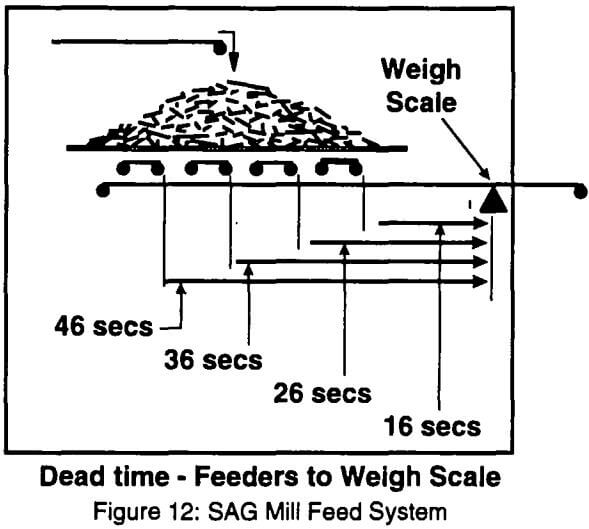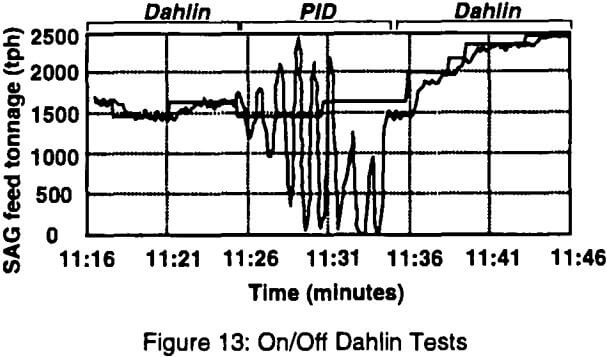- To participate in the 911Metallurgist Forums, be sure to JOIN & LOGIN
- Use Add New Topic to ask a New Question/Discussion about Grinding.
- OR Select a Topic that Interests you.
- Use Add Reply = to Reply/Participate in a Topic/Discussion (most frequent).
Using Add Reply allows you to Attach Images or PDF files and provide a more complete input. - Use Add Comment = to comment on someone else’s Reply in an already active Topic/Discussion.
SAG Mill Process Control (13 replies and 1 comment)
The purpose of a grinding mill is to convert electrical energy into rock breakage. The best use of that asset is to try to maximize the power draw. Try to hold the mill speed high and vary the feed rate to hold the weight (or bearing pressure), but watch out for "cycling" or "surging" that indicates instability in the charge. It is not easy, but is the best use of the capital cost of the mill.
I totally agree with you that setting a high speed to get a good cascade while varying the feed to hold the weight is the best way to control this operation. Some days ago I was on a site where the operators didn't agreed to this because - from their point of view - you should vary the weight within a range (manipulating the speed), but you shouldn't vary the feed-rate and just set it equal to the production rate target. I think this approach is not consistent.
There is a type of plant where the constant throughput SAG mill is sensible. If the SAG mill is not intended to be the rate-limiting step in a process plant, then it is best to adjust the SAG load (and power) to hold a constant tonnage to satisfy another constraint elsewhere. Underground mines are an example: the hoisting capacity of the mine shaft is the rate-limiting step in the process, and the SAG mill must adapt to what the shaft can supply. So yes, there are situations where constant tonnage is appropriate; but most SAG mill operators should target constant power draw.
This is why SAG mills are usual fitted with Squirrel Cage Induction Motors (SCIM) and Frequency Converters (VSD's). NB: Although this is also gaining acceptance on large Ball Mills. This allows the operator to "tune" the mill to the ore and liner characteristics. New liners will give more throw, so a speed reduction helps to avoid broken liners after a reline or with low charge levels. Old liners need more speed to maintain throughput, and more competent ore needs more energy to break.
Some large single line mines have other restrictions or bottlenecks (ball milling capacity, flotation or even crushing upstream) that will limit SAG throughput. We have also been involved with some sites that specifically target a production figure and set the mill feed-rate to achieve this, however then the mill "hunts" continuously around a speed range to achieve this as the inconsistencies in the ore are picked up and liners wear.
Do you mean that in case of large Ball Mills they intend to maximize the power or speed it up to get a cascade? Once I saw that the operator speed-up the Mill but at some point the weight started to oscillate constantly. I don't know if the cause was too much content of fine or if the Motor power was not enough to form a cascade (the feed rate was constant in this case too).
From my experience running PGM's concentrator plants i really agree with the operators. Continuously changing the feed to maintain constant load will possibly bring instabilities to your downstream process i.e. flotation in my case. Reagents addition is based on your throughput (g/ton ore milled) and the level of your expert system must be extremely good to adjust for these changes in feed. Once you have optimized the feed, the variable speed control on your mill can look after the load. There are couples of plants i know which had this VSD on their primary mills and they have been disconnected. Some because of downstream effects! Water control is extremely important and with feed changing this will need to be adjusted as well. If your density inside the mill is not controlled properly ball and liner wear (if not breakage) inside the mill will also be affected.
Treatment capacity is the result of operating mill in a healthy weight range that will ensure the optimum total level filling and utilization of full power which is the energy that is transforms and grinds. I recommend adjusting the weight for mill by tonnage and maximize the speed with caution. If the tonnage is not controlling the low weight, the speed takes the weight control.
There are two case, fixed speed and gear less. Our experience (2 concentrators with fixed speed, Los Bronces and El Soldado, and one with gears less in the El Teniente Concentrator) indicated that the strategy are different in each case. By the other hand, is very important the ore variability and if the layout have some crusher or pre crusher facilities. In both case the most important issue is achieve the nominal power capacity and its use in the comminution processes (avoid use in move amount). Our strategy is use high ball level until the nominal capacity with low speed (max 9,5 rpm), like a ball mill.
For ball milling, the aim is to achieve the maximum power draw of the mill at a constant speed. The cascade or trajectory of the charge is / can be influenced by the liner design (lifter bar profile, face angle, spacing etc.) For SAG Milling, optimizing the throw and converting the available electrical energy (installed motor power) to potential energy (height of throw, trajectory) to kinetic energy (rock breakage) is the key function. Therefore, having a speed range available allows this tuning of the SAG mill. That does not mean that the preference is speed control over feed rate control. Each ore is different and each plant is different. As equipment designers, we have to provide each of the features that the operators could use to optimize their process. In my experience, SAG Mills are normally variable speed, and Ball Mills are normally fixed speed. There are multiple ways to provide variable speed, the common ones are WRIM+LRS+SER or SCIM+VSD, the top of the range is gearless mill drives.
From my experience controlling the weight to maximize the power draw has resulted in improved throughput, but I have not much experience controlling variable speed Ball Mills since my focus on classification circuits has been on controlling the hydrocyclone efficiency. From this discussion I think that for a variable speed Ball Mill I should just consider a slow variation of speed considering the wear rate of liners.
I see now is something not working! Strange, because was working! So, maybe this resume is working: http://is.gd/u65HnK
An industrial example of its use is for the problem of SAG mill feed rate control, shown in Figure 12, which is notoriously difficult for a PID controller due to the long dead time. Figure 13 shows the results of on/off testing comparing Dahlin and PID control.


It depends on your goal. Beware with maintaining a constant supply of water to be able to follow the transport of material in the mill and prevent the accumulation of mass, otherwise the power signal will be unreliable, before any of the decisions you want to take.
There are maybe other factors that can be used to control the Sag but the feed size has a significant effect on its throughput the aim is running at a high throughput at a low power draw larger feed size tend to draw more power at the expense of low throughput

SAG Mill Process Control - What do you prefer? Controlling Weight (within a range) by manipulating mill speed and keeping a constant feed rate? Controlling weight by manipulating feed rate?